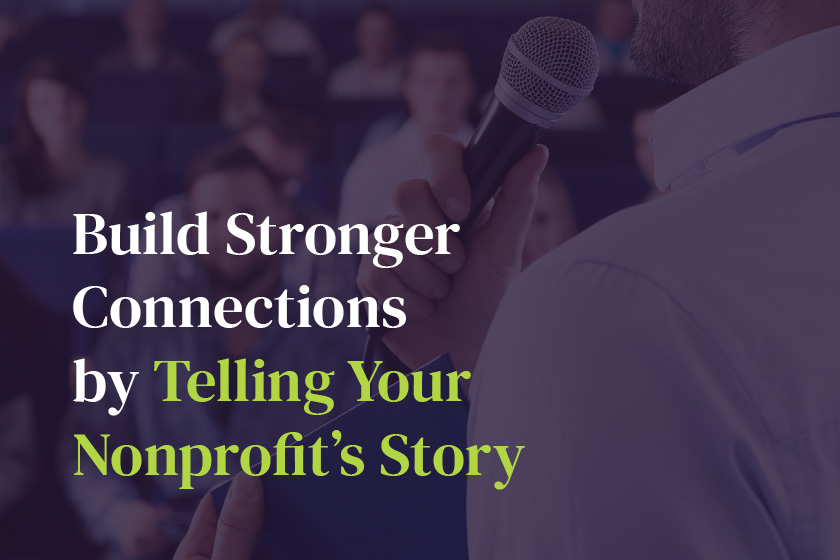Build Stronger Connections by Telling Your Nonprofit’s Story

To run a successful nonprofit organization, you need to convince people to support you and help you raise funds to further your cause. These tasks require providing a compelling fundraising case for support and using it as the basis of your marketing and promotional efforts. However, that’s often easier said than done: what are the best ways to convince people to lend their support to your cause?
One way to encourage people to support your organization is through great nonprofit storytelling. By using narrative and storytelling techniques, you’ll be able to communicate your nonprofit’s mission and impact while building stronger emotional connections with your audience.
To help you get started with nonprofit storytelling, this article will cover the following topics:
Well-crafted nonprofit stories will help you engage with your audience and inspire them to take further action. Plus, developing an emotional connection with and a deeper understanding of your nonprofit results in stronger relationships. These stories also lend authenticity and credibility to your nonprofit, as it shows the direct connection between your values and actions.
To help you leverage these benefits, let’s dive into where you should implement nonprofit storytelling.
Where Should You Use Nonprofit Storytelling?
Since storytelling principles are extremely versatile, they can be applied to many aspects of your nonprofit’s operations. Some places you can implement nonprofit storytelling include:
- Your website. Part of your website’s content strategy should be to educate visitors on what your nonprofit does. Integrating storytelling in your website can help tangibly demonstrate that to your audience.
- Social media posts. Social media platforms allow nonprofits to reach a wider audience. Weaving storytelling throughout your posts will pique the viewer’s interest and lead to greater engagement.
- Email newsletters. Storytelling can be extremely effective when utilized in your email campaigns. For example, let’s say you’re raising funds for a specific project or program. You can share a beneficiary’s story in your emails, explaining how they benefited from that program. This can create an emotional connection with readers.
- Annual reports. Having an annual report with great storytelling elements in it will cement your relationships with existing supporters and partners. Plus, it can help your nonprofit win over potential partners like grantmakers, resulting in more support and connections to help further your work.
Storytelling elements you can incorporate into these channels include character, plot, theme, narrative, and conflict. For example, a specific beneficiary could be the main character, the conflict could be the reason why they need your supporters’ assistance, and the plot could be revealed as you use your organization’s resources to empower them and help drive change in their life.
If you’re struggling with brainstorming ways to incorporate your nonprofit’s story throughout your marketing materials, consider working with a marketing consultant. These individuals bring their expertise and years of experience to create cohesive messaging for your nonprofit. They’ll take your nonprofit’s story and thread it throughout your promotional materials, ensuring that your supporters are engaged and develop emotional connections with your nonprofit.
3 Top Nonprofit Storytelling Strategies
Now that you know where you can use nonprofit storytelling, let’s dive into the top three strategies you should consider implementing.
1. Incorporate authentic and personal stories.
To create an emotional connection between your nonprofit and your supporters, incorporate authentic and personal stories from people involved in your community. Ask yourself: what kind of stories have moved you previously? Consider the answer to that question and how you can bring those elements to the stories you tell to your supporters.
For the greatest impact, collect stories from members of your nonprofit’s community such as:
- Beneficiaries. Giving more information about specific beneficiaries who your nonprofit has helped will illustrate the tangible impact you’ve had on your community and give your work a human face.
- Volunteers. Nonprofits can benefit individuals other than their beneficiaries. Share stories of volunteers, the work they’ve done on your behalf, and how they felt helping out.
- Donors. While donors might not directly benefit by aiding your nonprofit, some of your donors may have specific, compelling reasons for why they chose to make a gift. According to Graham-Pelton, you can use your prospect portfolios to identify donors with a greater capacity to give and share other donors’ stories to inspire them and provide social proof.
Aside from strengthening connections with existing supporters, incorporating authentic and personal stories will help you attract new supporters who are interested in the work you’re doing. And in turn, these supporters will become more invested in your nonprofit and may become volunteers or donors.
2. Highlight impact and transformation.
A common barrier for nonprofits is illustrating the impact they’ve created for their beneficiaries and their communities. To garner support, it’s important not just to make claims about the impact you’ve made—you need to provide some form of evidence to back up your claims.
Although incorporating stories of your community isn’t as concrete as data, they can still lend your nonprofit credibility. When weaving your narrative throughout your communications, social media posts, or web page, include anecdotes that highlight impact and transformation. You can do this by answering the following questions:
- What did your nonprofit do for this individual?
- How did this action change the individual’s situation?
- In what way did it improve the individual’s life?
For example, if you’re an animal shelter telling the story of a volunteer, quote them saying that your nonprofit offered an enriching volunteer experience that allowed them to learn more about animals in need. If the volunteer said they developed a deeper sense of compassion for animals and looked forward to de-stressing by helping care for puppies, include that as well.
Story collection can be an ongoing part of stewardship as you stay in touch with donors and learn more about their giving motivations and preferred ways to get involved. If you’re conducting rolling qualification conversations with top donors, get details about the last time they joined an event or chose to donate to a program and why. Talk with your on-the-ground volunteers. Send surveys to broader donor segments. Everything you learn about how and why donors interact with your nonprofit can help fill in the stories you tell, making them more concrete and ultimately more compelling.
3. Increase engagement with images and videos.
To broaden the appeal of your nonprofit’s stories, consider adding visual accompaniments. Having a photograph of a specific beneficiary as you tell their story will help supporters form a deeper connection, as it will personalize the story and make it seem more genuine. You might even consider employing a graphic designer to create compelling images related to your story.
Aside from adding images when possible, make your content more engaging by converting your stories into a video format. This will allow you to engage more of the viewer’s senses, creating a more immersive experience. According to Tectonic Video, a great nonprofit video should have a compelling narrative arc, be relatable, and tap into common experiences that audiences can connect with.
Images and videos are especially effective in your digital marketing strategy, as they provide a little extra intrigue to help you catch your audience’s attention. Keep in mind that people nowadays see a great deal of digital content, so it’s important to set yours apart with great images and videos!
Storytelling helps nonprofits form stronger connections with their supporters by guiding them to invest emotionally in the work that they’re doing. By weaving stories through your communications, you’ll be able to recruit more supporters to join your cause, establish a stronger digital presence, and build trust and credibility. So keep an eye out for creative ways to weave your nonprofit’s stories into your marketing materials!


